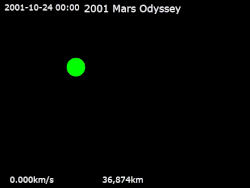
An areocentric orbit is an orbit around the planet Mars.
The areo- prefix is derived from " Ares," the Greek equivalent of the Roman god Mars. The name is analogous to the term " geocentric orbit" for an orbit around Earth and " heliocentric orbit" for an orbit around the Sun. As with these other orbits, the apsides of an areocentric orbit are sometimes called by specialized names: the pericenter is named periareon (analogous to " perigee") and the apocenter is named apoareon (analogous to " apogee").
The first artificial satellite to orbit another planet — the U.S. probe Mariner 9 — entered areocentric orbit on 13 November 1971. [1] Within a month, Mariner 9 was joined in orbit by two Soviet orbiters: Mars 2 (27 November 1971) and Mars 3 (2 December 1971). [2]
See also
References
- ^ Edward Clinton Ezell; Linda Neuman Ezell (1984). On Mars: Exploration of the Red Planet, 1958–1978 (NASA SP-4212). The NASA History Series. NASA Scientific and Technical Information Branch. p. 288.
- ^ V.G. Perminov (July 1999). "4.6 The Spacecraft's Struggle to Mars". The Difficult Road to Mars (NP-1999-06-251-HQ) (PDF). Monographs in Aerospace History. Translated by Katherine A. Nazarova. NASA. p. 57.